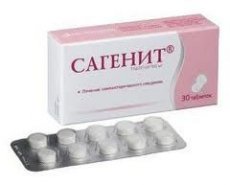Medical expert of the article
New publications
Preparations
Sagenite
Last reviewed: 03.07.2025

All iLive content is medically reviewed or fact checked to ensure as much factual accuracy as possible.
We have strict sourcing guidelines and only link to reputable media sites, academic research institutions and, whenever possible, medically peer reviewed studies. Note that the numbers in parentheses ([1], [2], etc.) are clickable links to these studies.
If you feel that any of our content is inaccurate, out-of-date, or otherwise questionable, please select it and press Ctrl + Enter.

Sagenit is an anti-climacteric drug, international nonproprietary name: mesodiethylethylenedibenzenesulfonate. Trade names - Sagenit, Sigetin. Manufactured in the Russian Federation.
Indications Sagenite
The main indication for the use of the drug Sagenit is climacteric syndrome, that is, the entire complex of vegetative-vascular, mental and metabolic-endocrine disorders that occur in women against the background of the fading of the hormonal function of the ovaries and the general age-related involution of the body.
The drug is recommended for relieving such symptoms of menopause as:
- "flushes" to the head, upper limbs and upper body,
- hyperhidrosis (excessive sweating),
- thinning of the skin and formation of wrinkles,
- brittle nails,
- dystrophy of the mucous membrane of the genitourinary tract,
- psychosomatic climacteric syndrome (sleep disturbance, irritability, mood instability, etc.).
Release form
The drug is available in tablet form. One tablet contains 100 mg of the active substance Sygethin - mesodiethylethylenedibenzenesulfonate dipotassium dihydrate. Sygethin is a biologically active substance (a derivative of 1,4-naphthoquinone) obtained synthetically; its chemical structure differs from hormones of natural origin, but it has a pronounced hormonal effect.
Pharmacodynamics
Most of the climacteric symptoms during menopause in women are associated with insufficient production of estrogens. Estrogen is a steroid hormone and is produced by the ovaries. It stimulates the development of the female reproductive organs, the formation of secondary female sexual characteristics, promotes timely rejection of the endometrium and regular menstrual bleeding.
After menopause, a decrease in estrogen levels causes vasomotor and thermoregulatory instability in many women (flushes of blood to the skin of the face), sleep disorders, partial atrophy of the genitourinary system, and osteoporosis.
The active substance of the drug Sagenit affects the functioning of the endocrinological network, which connects the hypothalamus, pituitary gland and ovaries and controls cyclic changes in the ovaries and endometrium (the internal mucous membrane of the uterus).
Sagenit reduces the gonadotropic function of the pituitary gland, i.e. the production of gonadotropic hormones (follicle-stimulating, luteotropic and luteinizing), which affect the function of the woman's ovary. In addition, the substance sigetin affects the hypothalamic center, whose functions include maintaining an optimal level of metabolism, regulating the body's temperature balance, the work of the cardiovascular, digestive, excretory, respiratory systems and endocrine glands.
The manufacturer of the drug Sagenit indicates that this drug does not have an estrogenic effect on target organs, i.e. it does not compensate for the deficiency of endogenous estrogens. At the same time, Sagenit increases uterine contractions and increases placental blood flow - blood circulation in the mother-placenta-fetus system (during pregnancy).
It should be noted that the analogue drug Sigetin (with the same active ingredient) is recommended as a stimulant for labor.
Pharmacokinetics
The manufacturers of this drug did not provide data on the pharmacokinetics of Sagenit.
Dosing and administration
The drug Sagenit should be taken as prescribed by a doctor in the following dosage: one tablet per day - regardless of food intake. The maximum permissible daily dose is two tablets. The recommended course of treatment is 30-40 days.
Use Sagenite during pregnancy
The use of Sagenit during pregnancy and lactation is not recommended.
Contraindications
Contraindications to the use of the drug Sagenit include increased sensitivity to the drug and uterine bleeding not associated with the menstrual cycle (metrorrhagia). The drug is prescribed with caution in the presence of such pathologies as renal failure, liver dysfunction, abnormally elevated levels of lipids and lipoproteins in the blood (hyperlipoproteinemia).
Side effects Sagenite
Taking the drug to relieve menopausal symptoms in women rarely causes unwanted side effects, which may include dizziness, nausea, vomiting, skin rashes, swelling of the eyelids, yellowing of the mucous membranes, sclera and skin (cholestatic jaundice), uterine bleeding (metrorrhagia).
 [ 1 ]
[ 1 ]
Overdose
Overdose of Sagenit is manifested by uterine bleeding and acute blood loss (hemorrhagic shock). In case of overdose, the drug should be discontinued; in case of significant blood loss, a blood transfusion or parenteral administration of blood substitutes is performed.
Interactions with other drugs
Sagenit enhances the effect of diuretics; the effect of drugs that normalize heart rhythm (antiarrhythmic); drugs that lower blood pressure (hypotensive); drugs that inhibit blood clotting (anticoagulants).
The therapeutic effect of Sagenit is enhanced by drugs containing thyroid hormones, as well as vitamin B9 (folic acid).
Storage conditions
Storage conditions for the drug: a dry place inaccessible to children, at a temperature not exceeding +25°C.
Shelf life
The shelf life is 2 years from the date of manufacture. After the expiration date, the use of the drug Sagenit is unacceptable.
Attention!
To simplify the perception of information, this instruction for use of the drug "Sagenite" translated and presented in a special form on the basis of the official instructions for medical use of the drug. Before use read the annotation that came directly to medicines.
Description provided for informational purposes and is not a guide to self-healing. The need for this drug, the purpose of the treatment regimen, methods and dose of the drug is determined solely by the attending physician. Self-medication is dangerous for your health.

